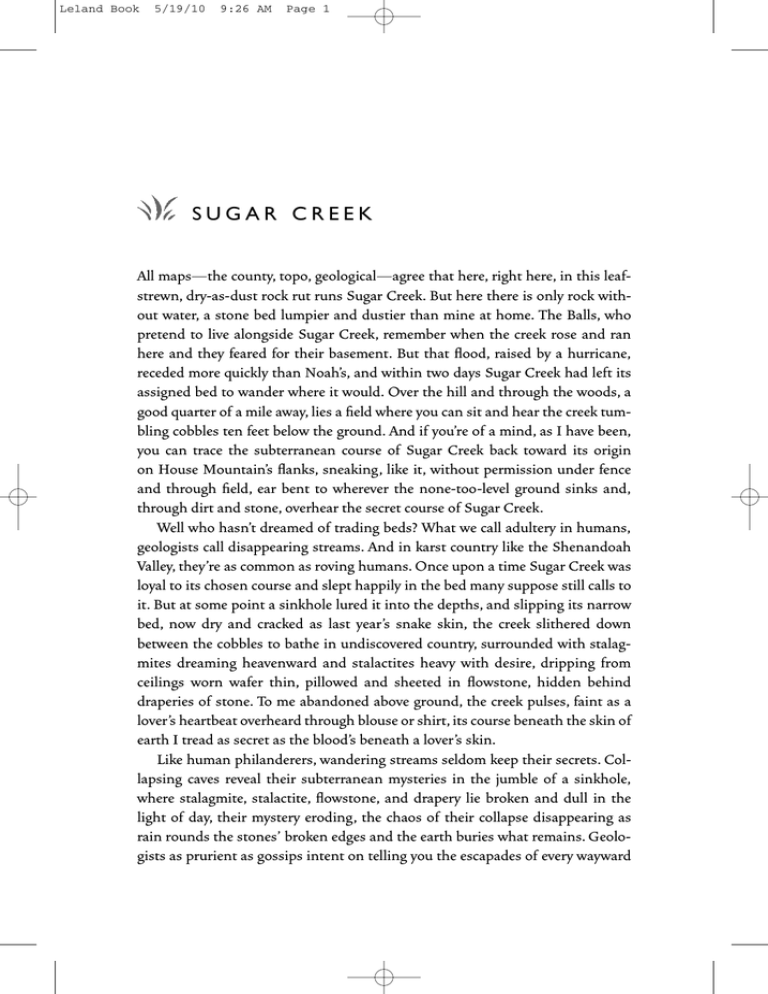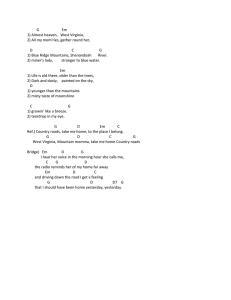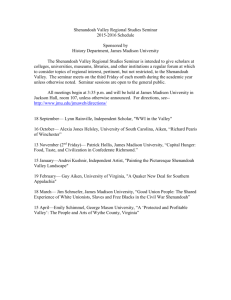S U G A R C R E...
advertisement

Leland Book 5/19/10 9:26 AM Page 1 SUGAR CREEK All maps—the county, topo, geological—agree that here, right here, in this leafstrewn, dry-as-dust rock rut runs Sugar Creek. But here there is only rock without water, a stone bed lumpier and dustier than mine at home. The Balls, who pretend to live alongside Sugar Creek, remember when the creek rose and ran here and they feared for their basement. But that flood, raised by a hurricane, receded more quickly than Noah’s, and within two days Sugar Creek had left its assigned bed to wander where it would. Over the hill and through the woods, a good quarter of a mile away, lies a field where you can sit and hear the creek tumbling cobbles ten feet below the ground. And if you’re of a mind, as I have been, you can trace the subterranean course of Sugar Creek back toward its origin on House Mountain’s flanks, sneaking, like it, without permission under fence and through field, ear bent to wherever the none-too-level ground sinks and, through dirt and stone, overhear the secret course of Sugar Creek. Well who hasn’t dreamed of trading beds? What we call adultery in humans, geologists call disappearing streams. And in karst country like the Shenandoah Valley, they’re as common as roving humans. Once upon a time Sugar Creek was loyal to its chosen course and slept happily in the bed many suppose still calls to it. But at some point a sinkhole lured it into the depths, and slipping its narrow bed, now dry and cracked as last year’s snake skin, the creek slithered down between the cobbles to bathe in undiscovered country, surrounded with stalagmites dreaming heavenward and stalactites heavy with desire, dripping from ceilings worn wafer thin, pillowed and sheeted in flowstone, hidden behind draperies of stone. To me abandoned above ground, the creek pulses, faint as a lover’s heartbeat overheard through blouse or shirt, its course beneath the skin of earth I tread as secret as the blood’s beneath a lover’s skin. Like human philanderers, wandering streams seldom keep their secrets. Collapsing caves reveal their subterranean mysteries in the jumble of a sinkhole, where stalagmite, stalactite, flowstone, and drapery lie broken and dull in the light of day, their mystery eroding, the chaos of their collapse disappearing as rain rounds the stones’ broken edges and the earth buries what remains. Geologists as prurient as gossips intent on telling you the escapades of every wayward Leland Book 2 5/19/10 9:26 AM Page 2 LEAR NI N G T H E VAL L E Y relative decipher the tangled marriages, divorces, and remarriages of streams captured, stolen, pirated, and disappeared. From them we learn the sordid truth behind the Blue Ridge’s ragged profile. The Potomac, James, and Roanoke rivers run through water gaps in the Blue Ridge. Scattered in between are wind gaps, notches lower than the prevailing three- thousand-foot height of the Blue Ridge, through which rivers to the east once flowed before their headwaters, seduced by the Shenandoah River, the “Beautiful Daughter of the Stars,” turned west and north. Manassas Gap, where Interstate 66 crosses the Blue Ridge, is the lowest of Virginia’s wind gaps at 850 feet. Swift Run Gap, 2,365 feet high where the Rapidan River fails to pierce the Blue Ridge, bears like a bitter ex-wife the name of her faithless spouse who long ago ran off with the Shenandoah. Farther south still, Rockfish Gap, where Interstate 64 crosses the Blue Ridge at nineteen thousand feet, overlooks South River, philandering north toward the seductive South Fork of the Shenandoah. Closer to home, the Natural Bridge of Virginia rises indignant over Cedar Creek, who seduced the waters of Poague Run to run away with it through an underground tunnel whose sole surviving bit is the two-hundred-foot-high bridge. These philandering streams wear their infidelities openly. Not so Sugar Creek, preferring to hide as best it can its cheat. No geologist has ever glimpsed the creek’s hidden boudoir, guess though they may its nature by comparison to less circumspect streams that carve their ways through open caves. Some even make money off their buried lives—Dixie, Endless, Luray, and Natural Bridge Caverns but four who lay themselves bare for passersby to marvel at their mysteries. We also pay spelunking shrinks good money to inspect the muddy relics of hearts we ourselves have tried to capture or steal in our day. Imagine their job, hour after hour, day after day, listening to us fondle, Gollum-like, our precious, precious memories. Better they than those we betrayed. For who hasn’t, insomniac at 3:00 a.m., wondered whatever happened to old what’s her name? I’ve never been quite drunk enough to do what some do—call up at an ungodly hour a long-lost love and thus confirm her wisdom in having dumped me years earlier. But there are nights I wonder if she too remembers. Does Sugar Creek also remember with regret her abandoned bed? And does her bed yearn yet for her return? It’s only a creek, Leland. You may think the sound of water coursing over cobbles sings of a buried life, but water’s water and rock’s but rock. And would my heart were as hard. The sinkhole behind the Balls’ home fills with water after a really good rain, and then, where wild turkey and I have trod, mallards swim. The temporary lake ponds up against a rock ridge thirty feet high, through which the buried creek Leland Book 5/19/10 9:26 AM Page 3 SUGAR CREEK 3 must trace a tunnel as strait and narrow as the Bible’s, flood waters waiting days to pass through to the other side. And once there, where do they go? For downstream of the ridge, the ground is silent. Here there is only dry stone and no sound of water. Farther down valley, flanking John Jordan’s old toll road, the farmstead stands where it does because water cold and sweet as an unfaithful spouse’s kiss springs boldly out of the ground. And Sugar Creek rejoins the bed cartographers trace in blue ink on their maps, behaving like a good creek should, flowing overground where you can see it and, in spring and summer, dangle your toes in its water and chase the minnows down the limestone rock ledges toward Effinger. Here the creek has carved a narrow valley, open fields on one side and cedar forest on the other. Whoever owns the land has not yet chopped it up into farmettes, so that a walk here is a trip back in time, the narrow roadbed following the creek, which follows its proper bed, the cows happily eating grass and shitting into the spring where I get my watercress and mint, and a noisy kingfisher patrolling what he obviously supposes to be his creek. And who downstream, the creek now keeping to its narrow bed, guesses its hidden life? Leland Book 5/19/10 9:26 AM Page 4 R O C K C RY S TA L S Although it is tempting to look at the forest around us as we hike House Mountain, Edward and I have eyes only for the ground, seeking the glint of sun against stone. We are hunting crystals. We have a treasure trove at home, Edward having a pack-rat personality and a loose definition of crystal. Anything quartz will do, so that we have bags of what, to me, are unpromising rocks little different from what you might buy at your local garden center but which are, Edward assured me when we gathered them, precious crystal. We slowly climb the trail, scuffing the leaves and peering at every glint. Fragments of glass, mostly, but now and then, quartz, often as not the broken tip of a long-vanished crystal, milky with impurities and fraught with fracture lines, worth keeping, of course, but not what we are really after. That is six-sided prisms clear as ice. When we first hunted, I’d spy a crystal and call Edward over to search the area around my feet, guiding his impatient glances here, there, and everywhere until he’d see it and yell, “Look, Daddy,look—a crystal!” But now his youthful eyes find more crystals than my old ones, so that I enjoy his joy in finding these melted remains of long-vanished beaches. Little House Mountain’s spectacular summit is a warren of eroded sandstone, carved over time into a maze well worth wasting an afternoon exploring. But what to a hiker seems huge is but a half mile long and only several hundred feet wide, a small purple lozenge on geological maps lost in the pink sea of the Martinsburg Formation that forms House Mountain’s massive flanks. Named after Martinsburg, West Virginia, where it was first scientifically described, the formation’s several thousand feet of shale and limestone were laid down more than four hundred million years ago, offshore of vanished mountains then rising to the east of today’s Shenandoah Valley. As the mountains eroded, the sediments changed from easily weathered particles to purer and purer erosion-resistant quartz, which today makes up the capstones of Little and Big House Mountains. What today’s sun warms was warmed millions of years ago by the earth itself, the Martinsburg’s eroding limestones and shales having been buried by geologists only know how many thousands of feet of now-vanished sediments. But Leland Book 5/19/10 9:26 AM Page 5 RO C K C RYS TA L S 5 deep enough to have melted silicon, which, combined with oxygen, forms silicon dioxide, or quartz. And silicon dioxide sometimes decides to make itself into sixsided prisms tipped with pyramids at either end, although such perfect crystals are rare, most being multiple, distorted, and often clouded, opaque, or milky. But a surprising number of House Mountain’s crystals are perfectly clear, six-sided rock crystals. Before Edward began carrying much of House Mountain home with him, back when I hunted alone, a morning’s search might yield a handful of crystals. Off to Lexington jeweler Mr. Hess I would go with my bag of crystals, and we would sort them, discarding this one and that one, seeking the crystal perfect enough for my thirteen-year-old daughter’s neck, or two twinned beauties to dangle from her ears. Mr. Hess never made much money off my crystals, but I know he enjoyed our mornings together, telling me of his youth when, he swore, the newly tilled cornfields sparkled with crystals ready for the picking. Today’s duller world raises cattle, not corn, when it farms at all, and a Rockbridge County kid is more apt to find crystal in a suburban excavation than a field. But Kathy Ball still tills the earth by hand, and she once gave me as an engagement present a pink-tinged beauty of a stone she had plowed up in her garden, a stony miracle, twinned crystals married forever. My marriage proved less durable than nature’s, and I no longer gaze upon that crystal or the woman I thought it represented. Nor does my daughter, Isabella, still wear the crystals I hunted her, having found stones more precious in her sight than those. But they remain, gathering dust in the corner of her jewelry chest. And who knows, perhaps one day her daughter’s daughter will discover them, and lift them from the surrounding tangle of storebought jewelry and learn of a man she never knew who gave her grandmother frozen ice. For such the Roman naturalist Pliny thought quartz crystals were, the word crystal coming from the Greek for ice. The Bible also thought crystal special, Ezekiel’s four beasts supporting a firmament “the color of the terrible crystal,” while Revelation’s “sea of glass” was “like unto crystal.” Edgar Cayce reported that Atlantis was powered by giant crystals, one of which still lies in the heart of the Bermuda Triangle. Native Americans also favored crystals, archeologists having discovered they traded them throughout what is now the Southeastern United States. Europeans were also attracted to the stones, and stone churches in southwest Virginia include large, seven-inch-long crystals in their walls. And once upon a not so long time ago, such crystals were the stuff of national security. Nineteenth-century scientists confirmed earlier research that suggested certain materials, including quartz, generate an electric charge when stressed. This Leland Book 6 5/19/10 9:26 AM Page 6 LEAR N I N G T H E VAL L E Y piezoelectricity, from the Greek for squeeze or press, created a demand for flawless quartz crystals that could be cut and used in sonar, phonograph, and radio transmissions. With luck, a skilled worker could produce twenty usable crystals a day. The United States Army’s 1939 decision to convert its radio equipment to crystals resulted in a run on quartz, which in those days came primarily from Brazil. German U-boats might sink ships carrying quartz, and so the army took to flying the crystals home, so necessary were they to the war. Efforts to locate domestic sources of suitable quartz led geologists to Arkansas, California, western North Carolina, and southwestern Virginia. Almost all Virginia’s crystals occurred, not in veins, but in the weathered soil. Many were turned in by farmers. Following World War II, researchers turned to manmade piezo ceramics, which were both more easily obtained and of surer quality than natural quartz. So that Virginia’s crystals are no longer crucial to national security. Though they are to my personal security, transporting me back to days when my children were young enough to think hunting such things on a mountain’s flank a great way to spend an afternoon. More sacred than the jar of stones gathering dust in my basement are these memories,rock hard and crystal clear despite the years, enduring even as time wears me down. Leland Book 5/19/10 9:26 AM Page 7 THE SHENANDOAH SEA When temperature inversions trap warm air in the valley, fog forms, islanding House, Jump, and Hogback Mountains, until noon, when the sun burns off the clouds, and the valley returns to being a valley. But while the fog lasts and I’m perched on a hill lapping House Mountain’s flanks and I look over the southwesttrending archipelago of Short Hills, I believe in Thomas Jefferson’s Shenandoah Sea, a mythic ocean that stretched from Blacksburg, Virginia, into Pennsylvania where it poured into the Atlantic with the Susquehanna River. Twenty miles wide, two thousand feet deep, three hundred miles long, the Shenandoah Sea was close cousin to those will-o’-the-wisp oceans sought by Europeans in search of the Northwest Passage, always just over the next hill, around the river’s bend, over there, someplace else. In Notes on the State of Virginia, Jefferson described Harpers Ferry as “one of the most stupendous scenes in nature . . . worth a voyage across the Atlantic,” imagining it the relic of “a war between rivers and mountains.” Dammed up by the Blue Ridge Mountains, the Potomac and Shenandoah rivers “formed an ocean which filled the whole valley; that continuing to rise they have at length broken over at this spot, and have torn the mountain down from its summit to its base. The piles of rock on each hand, but particularly on the Shenandoah, the evident marks of their disrupture and avulsion from their beds by the most powerful agents of nature, corroborate the impression.” Charles Thomson corroborated his friend Jefferson’s surmise, asserting that “what is now a fruitful vale was formerly a great lake or collection of water, which possibly might have here formed a mighty cascade, or had its vent to the ocean by the Susquehanna, where the Blue ridge seems to terminate.” Thomson imagines it a southern version of the Great Lakes, and then wonders if the Gulf of Mexico itself might not have been “a champaign country,” “a vast plain” flooded by the Atlantic’s having breached “a continued range of mountains through Cuba, Hispaniola, Porto rico, Martinique, Guadaloupe, Barbados, and Trinidad.” Salt or fresh, lake or ocean, the Shenandoah Valley was once water. And fossil shells confirm the story. House Mountain’s flanks rise from the valley floor as round and steep as a sleeping Leviathan’s, and a scramble up one of Leland Book 8 5/19/10 9:26 AM Page 8 LEAR N I N G T H E VAL L E Y them leaves my son, Edward, and me sweating, a quick lick of the upper lip suggesting that the breeze cooling us as we sit under the tropic-shaped shade of an ailanthus tree blows from off seas just over the hill. Shells litter the stone littoral we sit on, the Confederate-gray lime matrix chockablock with the star-shaped stalks of crinoids scattered like a fallen Milky Way among clamlike brachiopods in beds as thick as mussels, the broken bowls of coral-like bryozoans, and, find of finds, the three-lobed head of an occasional trilobite. At home, bookshelves heavy with our trawl prove to even the most skeptical that what is land was once upon a time water fathoms deep. Jefferson and Thomson imagined Harpers Ferry a spectral Niagara Falls, the Potomac and Shenandoah riverbeds still choked with remnants of the falls. The Shenandoah Sea had just vanished, its vacant bed half moist, and if we but squint when standing at Harpers Ferry we can almost see it lapping the sides of the Blue Ridge and Allegheny mountains.Not so, says modern science, which has not only pushed the sea back, back, back into the mists of time, but come at last to deny its ever having existed. Jefferson supposed, “The first glance of this scene hurries our senses into the opinion, that this earth has been created in time,that the mountains were formed first, that the rivers began to flow afterwards, that in this place particularly they have been damned up by the Blue ridge of mountains.... ” The devout of his time thought otherwise, believing with Genesis that God had created the universe in seven days, not “in time.” Opinion divided on when the mountains had been formed, some supposing them to have risen with Eden, others that they were the remnants of Noah’s Flood, carved out as the waters of the Deluge poured first forth and then back into the fountains of the earth from whence they came.Modern science too is skeptical; Jefferson, though right in thinking “that this earth has been created in time,” got it backwards; the sea was first, the mountains and rivers second. In truth, there never was a Shenandoah Sea; the valley has long been just that, a valley, dry land. The Shenandoah and Potomac rivers arose, it is thought, when the mountains rose, gravity forcing the rising land to drain into rivers that ran parallel to the resistant rocks of the Blue Ridge until they found a way eastward, not in a cataclysmic Niagara Falls of a flood, but in a gentle and ever so gradual erosion that still goes on today. And the rivers began, not six thousand years ago as Genesis supposes, but 280 million years ago, when the drifting continents of Africa and Europe and North America collided and formed a mountain range perhaps as grand as the Alps that time and water have gradually worn away to today’s stumps. The continents backed away from each other, the Atlantic Ocean Leland Book 5/19/10 9:26 AM Page 9 T H E S H E N A N D OA H S E A 9 widening at the glacially slow rate that fingernails grow, so that it took 220 million years to reach its current width. The valley itself was once mountain, rising no one knows for sure how high, its billion of tons of rock dissolved and eroded eastward to the coastal plain, which is but sand from the vanished peaks of the Shenandoah Mountains. You can see this if you look at the flanks of the mountains enclosing today’s Shenandoah Valley; the bedrock slants up, pointing skyward over the valley itself toward vanished mountaintops, back to a time when the mountains were laid low and the valleys exalted. If ever there was a sea here, it was before all this, so way back that I have to imagine the years as quarters of inches laid out end to end on the earth, time a colossal ruler running westward from where I stand at the corner of Main and Nelson streets in Lexington. Columbus discovered America 128 inches ago, more than ten feet to the west; the Indians came across from Asia 2,500 inches ago, 208 feet west of here and 83 feet west of where Genesis has God creating the earth in 4000 b.c.e. Now the math gets tough. The dinosaurs died out 16,250,000 inches ago, 256 miles west of here, somewhere in West Virginia. The Atlantic Ocean began to spread 220 millions years ago—864 miles west of me, in Topeka, Kansas. The Blue Ridge and Allegheny began to rise 280 million years ago—1,104 miles west of here, near Dodge City, Kansas. And the valley’s sea shells were laid down 400 million years ago in the Silurian period—1,600 miles west of here on my ruler, somewhere in Utah. It’s hard to get a handle on all this, especially when the view says otherwise. Taking the guide and survey books, I slowly, ever so slowly, decipher their geological jargon of allochthon, facies, graben, karst, anticline, scarp, slump, strata, strike-slip, and syncline so that the self-evident sea of the Shenandoah evaporates and the mythical mountains of Pangaea and its dissolution rise before me. For I am a believer. And what it is, in my case at least, is belief, not knowledge, which I came to understand when discussing a fossil rock embedded in the cafeteria wall of the college where I teach. Casually stating that the shells we saw were from the Silurian period, some four hundred million years old, I was caught short by a student who insisted that the earth was only six thousand years old and these shells the remains of Noah’s Flood. And there we were: a born-again eighteen- year-old facing a middle-aged English teacher and what he half understood of modern geological theory. We still stand there, because, to be honest, I have no way of proving my beliefs any more than did the student. Thanks to his beliefs, however, I’ve read a half dozen books on the young-earth theorizers, Christians all, who take the Bible as their guide and fit the facts to its procrustean Leland Book 10 5/19/10 9:26 AM Page 10 LEAR NI N G T H E VAL L E Y bed. And if I had not been inoculated by just whom I’m not sure—although highschool science teachers, television, and a certain predilection I have for following the crowd and toeing the line are good candidates—I could believe as well. The cataclysmic crowd who suppose these mountains remnants of a mighty flood of some kind, be it Noah’s or the draining of the Shenandoah Sea, have appearances on their side, as the view confirms. Even those who prefer a scientific explanation of the mountains around Lexington may mistake their origin. I’ve made a habit of asking Lexingtonians where they think House Mountain came from: volcanoes, the Ice Age, and plate tectonics are the most popular candidates. Just what the latter means no one seems sure, but they’ve all seen pictures of Pangaea in books and are believers. The Ice Agers are similar in their beliefs; they know there was an Ice Age in North America and incorrectly suppose it came through Virginia, carving out mountains as it went.The vulcanists, mistaken though they too be,have appearances on their side; House Mountain does look something like a truncated volcano when viewed from town. But were they to circumnavigate the mountain, they’d see the volcano transform itself into two breasts outside Collierstown and a narrow defile in Denmark. Lexington’s share of the Great Valley seems all too tranquil a setting for plate tectonics. To believe in them, I have to drive west to North Mountain, where John Jordan’s old toll road to glory snakes its scary way seven miles up and seven miles down. Here the sandstone ridge cap slants at a near 45 degree angle so that you have to clamber up its fissured and cracked surface to perch at the edge of nothing and look out at House Mountain seemingly within spitting distance and begin to understand that something humongous sat down somewhere to so push these rocks out of their original horizontal alignment. It’s tempting to think that the something sat somewhere behind you to the west, since the rock sinks down that way, but the ones who know say that these west-sinking sandstones are part of a huge section of eastern Virginia crumpled up and pushed so far west by the wandering continent of Africa that the rock formations visible in the valley repeat themselves underground, as if a massive stack of rugs had folded upon itself. North Mountain’s two-thousand-foot rise from the valley floor represents merely the ragged remnants of long worn-away layers of this carpet. What caps these mountains may slant today, but the geologists say it was laid down as sandy beach and shoal 425 million years ago in a Silurian-aged Cape Hatteras flanking mountains somewhere to the east, where today there is only the Piedmont, the Atlantic coastal plain, and the Atlantic Ocean, the mountains having eroded away long, long ago. Jefferson was right in a way. The Shenandoah Leland Book 5/19/10 9:26 AM Page 11 T H E S H E N A N D OA H S E A 11 Sea did exist, though long before the Shenandoah Valley was carved from the mountains we see today. And it stretched, the savants say, west into today’s Great Plains. The view alone is worth the drive up one of our mountains some morning when the fog hangs low in the valley and Jefferson’s sea is wholly believable and to sit and watch the clouds dissolve and science’s reasonable if less-than-exciting view of landscape prevail again. Then you know that whatever cataclysm, rapid or slow, carved out this valley had aesthetics on its side. And you will look and see, like God, that it is good.






